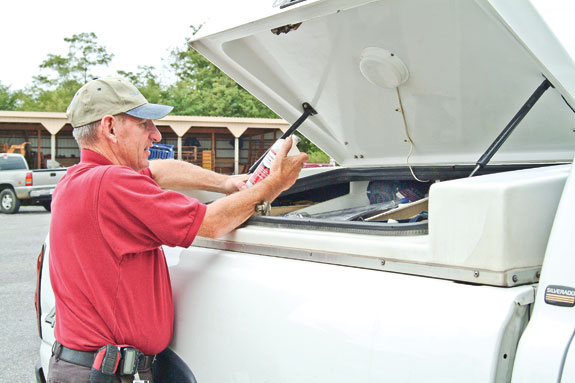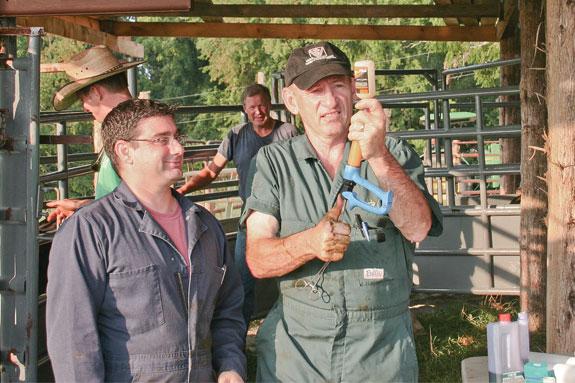These prerequisites generally include certain vaccinations and pre-weaning.
A growing number of producers have found that pre-weaning calves makes sense and makes money.
William Dee Whittier, a professor of large animal clinical sciences at Virginia-Maryland Regional College of Veterinary Medicine, Virginia Tech, says his state has a feeder cattle marketing program called Virginia Quality Assured (VQA), which is utilized to identify and market feeder cattle that meet superior health and genetic requirements.
The goal is to enhance the reputation of Virginia’s feeder cattle by improving their health, genetics and marketability. It’s attractive to buyers and producers, rewarding producers for their efforts.
There are several facets to the program, and producers can choose which ones fit their operation when marketing calves.
The Gold Tag program is the basic program that focuses on health requirements, while the Purple Tag program includes both health and genetic requirements. Each program has two options – weaned and unweaned.
Calves in the Gold Tag health-assured program must be vaccinated according to program specifications. Gold Tag with W specifies that calves have met all Gold Tag requirements, have been weaned at least 45 days and have learned to use feed bunks and water troughs.
Purple Tag calves must meet all Gold Tag requirements plus the sire must meet minimum yearling weight EPDs and be identified by breed. Purple Tag with W means calves meet all Purple Tag requirements plus be weaned at least 45 days and know how to use feed and water troughs.
“We put these ear tags in the calves we certify,” says Whittier. “This is a third-party verification program.
The first party is the producer, the second party is the person buying the calves and the third party is an independent entity, usually our extension agent, a veterinarian, VQA personnel or someone who has been trained as a certifier.”

Getting the shots started
At the center is a vaccination program. “Calves must be vaccinated for seven-way clostridial, IBR, two strains of BVD, PI3 and BRSV and Manheimia.
We now require a modified-live vaccine as part of that program. We don’t specify a brand or manufacturer.
We just require that producers use vaccines according to label directions. With some of those products it can be done with a single injection, while others require a booster.”
Vaccines must be given at least 21 days before marketing date – at some point after 120 days old. “The producers also need to keep track of serial numbers and expiration dates and document the products they use and how they use them,” he says.
All producers must be BQA-certified. “They’ve all gone through training,” he explains. “All shots must be given in front of the shoulder. We follow all BQA guidelines.”
Other requirements for calves in any VQA program include minimum weight of 400 pounds, heifers guaranteed open, steers castrated and healed (no stags), all calves dehorned and healed, and owned by the seller for at least 60 days.
Weaning protocols
“We also have a weaned option,” Whittier says. “When we started the program, people thought it would be hard to get producers to wean their calves because some thought they didn’t have the facilities or ability to do it.
But in the 15 years we’ve been doing this program, we’ve gone from 5 percent of calves being weaned to about 90 percent of calves being pre-weaned before market.”
Pre-weaned calves have grown in popularity with clients in farm regions, Whittier says, and the program utilizes weaning systems on producer farms.
“Some use commodity feeds and others use corn silage-based rations,” he explains. “A few are backgrounded on grass.
Not only do producers get increased value – a better price for their calves – but they also get the added pounds.”
If calves are weaned properly, they keep right on growing. “Most of our producers are good at weaning calves and they don’t lose weight.
We’ve come back and weighed calves two weeks later and the calves have gained 25 pounds.”
The VQA pre-weaned program requires 45 days of weaning. During that time, some people put 100-plus pounds on their calves.
“Feed is expensive, but these calves probably have some compensatory gain,” Whittier says. “Cost of gain ranges from 60 cents per pound to 90 cents per pound. It makes economic sense, with the value of feeder calves in today’s market, to wean them.”
The producer may make a $50 premium just because calves are pre-conditioned, and another $50 from additional gain in 45 days. “It’s hard to believe that some people still prefer to haul bawling calves to market,” he says.
Whittier says formal studies haven’t been done to show whether the calves have less sickness. But from his view the program sees very little disease with backgrounding when cattle stay home. By separating the stress of weaning from shipping, producers avoid two of the biggest stressors in a calf’s life.

Co-mingling the shipment
Some of the programs with the cattlemen’s associations put groups of cattle together. “Co-mingling is almost a necessity in many operations in our state where we have relatively small farms,” Whittier said.
“We’ve learned that you can live with co-mingling if you don’t add the stress of weaning and a tough marketing on top of it.”
Producers place co-mingled calves together early in the morning, and by mid-morning they’re in the station where they are putting together these loads.
“By evening the calves are in their new home,” says Whittier. With rapid marketing and weaned calves that know how to eat and drink, stress is minimized.
The traditional ideas about weaning and pre-conditioning are no longer valid. “The original prejudices included buyers thinking these calves were too fat (being fed grain for 45 days or more before market) and that the producer had stolen that cheap gain.
We have different genetics now. These calves go to the feedlot and keep right on gaining. It’s taken a long time to overcome some of the old ideas, but we have a large group of buyers willing to pay a premium for pre-weaned calves.
“The same is true for the VAC-45 program that calf sellers use in the West. They sometimes have a commercial spin to them, specifying certain vaccine companies.
We decided to not pick a company, but just say there are lots of good vaccines available and that producers should follow label directions,” he says.
If buyers eventually expect to have pre-weaned calves as the “norm” (without a premium), this would mean that unweaned, unvaccinated calves would be discounted, Whittier says.
“The new standard in the industry is pre-weaning and putting calves through a short, high-quality backgrounding program before they are moved or marketed.
There is a many-tiered system for pricing calves and at the top are high-quality calves that have been through this backgrounding, are weaned and ready to go to work.” ![]()
PHOTOS
TOP: These Virginia Quality Assured cattle earned the Purple Tag, which requires standard health rules, plus additional rules for sire minimum yearling weight EPDs and identification.
MIDDLE: As part of injection protocols, the Virginia Quality Assured program requires no certain brand of medicine, just that producers use vaccines according to labels.
BOTTOM: Preconditioning plans typically require vaccines be given weeks before marketing date. In the VQA, they come after calves are 120 days old. Photos courtesy of Dee Whittier







